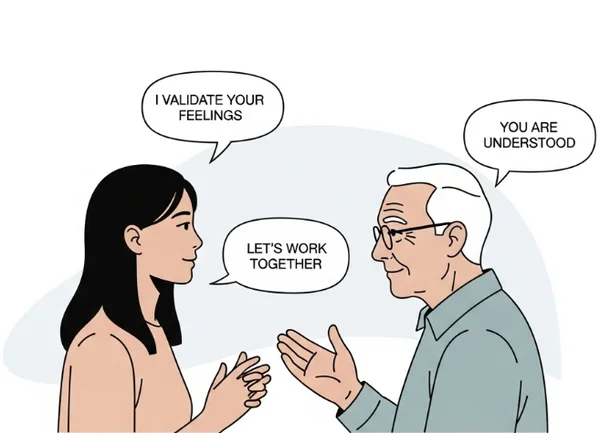为神经多样性人士创建支持性环境
理解和接纳是真正 支持神经多样性个体 的基石。无论您是家庭成员、朋友、教育工作者还是同事,了解如何营造包容的氛围都会产生巨大的影响。本文提供了实用的 神经多样性包容性小贴士 和关于 为神经多样性人士创建安全空间 的建议,让他们可以茁壮成长。我们的目标是为您提供可操作的策略,让您成为更好的盟友。如果您想了解基础知识,您可以先 在我们的网站上探索神经多样性的含义。
支持神经多样性个体的关键原则
在深入探讨具体环境之前,让我们先确立一些总体性的 神经多样性支持原则。如何有效支持神经多样性人士?
培养同理心和积极倾听
尝试从他们的角度理解世界。积极倾听他们的经历,不带评判或打断。验证他们的感受,即使您不完全理解他们的内心体验。同理心是 支持神经多样性个体 的基础。
自我学习:了解不同的神经类型
知识就是力量。了解不同的神经类型(如自闭症、多动症、阅读障碍)以及它们如何表现。了解常见的特征、优势和挑战可以帮助您定制您的支持。但是,请记住,每个人都是一个个体。

尊重个体差异和偏好(避免一刀切)
神经多样性意味着多样性。对一个神经多样性的人有效的方法可能对另一个人无效,即使他们具有相同的神经类型。避免做出假设,并始终尊重个人的偏好、界限和沟通方式。
关注优势,而非仅仅是挑战
每个人都有独特的优势。虽然可能存在挑战,但仅仅关注它们可能会削弱力量。认识并庆祝神经多样性个体带来的才能、热情和独特的视角。
多询问,少猜测:让个体参与支持
了解如何支持某人的最佳方式是询问他们(如果合适且他们能够沟通这一点)。尽可能让他们参与到有关他们环境和支持需求的决策中。这可以培养自主性和尊重。
在家中创建安全空间:家庭提示
家应该是一个避难所。以下是如何提供 家庭中的神经多样性支持。
建立清晰的日常作息和可预测性
许多神经多样性个体在日常安排和可预测性中茁壮成长。明确的膳食、活动和就寝时间表可以减少焦虑并创造安全感。如果可能,提前沟通日常安排的变更。
管理家庭环境中的感官敏感性
注意感官敏感性。这可能包括调暗灯光、降低噪音水平、使用无香味产品或提供具有首选质地的舒适服装。创建一个“感官静养地”,让他们可以在那里放松。
清晰且一致的沟通策略
使用清晰、直接和一致的语言。如果成语或讽刺会引起困惑,请避免使用。视觉辅助工具、书面说明或将任务分解为更小的步骤可能有助于 支持神经多样性的家庭成员。

认可情绪和体验
承认并验证他们的情绪,即使它们在您看来与实际情况不成比例。让他们知道表达他们的感受是可以的,并且您会在那里支持他们。
提供放松时间和减压空间
社交互动和日常需求可能会让人感到疲惫。确保他们有机会安静地休息和拥有个人空间,在那里他们可以放松身心,在没有压力的情况下恢复精力。
在教育环境中培养神经多样性包容性
教育工作者在 支持神经多样性学生 中发挥着至关重要的作用。
针对不同的学习方式调整教学方法
认识到学生以不同的方式学习。结合视觉、听觉和动觉教学方法。以各种格式提供材料,并允许以传统测试以外的不同方式展示理解。这是 教育中的神经多样性 的关键。
提供清晰的指示和期望
将作业分解为易于管理的步骤。提供清晰的书面指示以及口头指示。清楚地概述对行为和学业表现的期望。
创建一个感官友好的教室
尽可能减少视觉混乱和听觉干扰。允许休息或使用小工具来帮助集中注意力。考虑为感到不知所措的学生提供一个安静的角落。

促进同伴理解和接纳
以适合年龄的方式教育所有学生关于神经多样性的知识,以培养同理心并减少欺凌。鼓励包容性的集体活动并庆祝差异。
与家长和专家合作
与父母/监护人保持开放的沟通,并与专家(如职业治疗师或特殊教育教师)合作,以实施有效的支持策略。
构建具有神经包容性的工作场所:给同事和雇主的建议
创建 工作场所中的神经多样性 文化对每个人都有好处。
提供灵活的工作安排
在可能的情况下,提供工作时间的灵活性、远程工作选择或安静的工作空间。这可以帮助神经多样性员工更有效地管理感官输入和能量水平。
明确的任务委派和沟通
为任务提供清晰的书面说明。设定明确的期望和截止日期。如果主动更新存在挑战,请提供定期的检查,而不是仅仅依靠主动性。神经包容性就业 实践重视清晰度。
尽量减少办公环境中的感官干扰
考虑采用“感官感知”的办公室设计。这可能包括调光照明、降噪耳机或无香政策等选项。

培养尊重和理解的文化
提高所有员工对神经多样性的认识并进行培训。鼓励公开对话并挑战刻板印象。确保 支持神经多样性的同事 是公司文化的一部分。
根据个人需求提供便利
准备好根据个人需求提供合理的便利,例如辅助技术、改造的工作空间或替代沟通方法。
在社交场合中支持神经多样性的朋友
友谊和社交互动很重要。您如何成为一个支持性的朋友?
对沟通差异保持耐心和理解
了解您的朋友可能会以不同的方式进行沟通。他们可能非常直接,错过微妙的暗示,或者需要更多的时间来处理信息。练习耐心,并在需要时要求澄清。这是 神经多样性社交技能支持 的一部分。
尊重界限和对孤独的需求
神经多样性个体可能具有不同的社交能量水平。尊重他们需要独处的时间来充电,并且如果他们有时拒绝社交邀请,请不要介意。
参与他们的特殊兴趣
对他们的热情和特殊兴趣表现出真正的兴趣。这可能是建立联系和建立更牢固友谊的好方法。
选择对神经多样性友好的社交活动
在计划社交活动时,请考虑不太可能造成感官超负荷的环境。选择更安静的环境或符合他们兴趣的活动。
成为一个可靠且不带评判的朋友
提供始终如一、可靠的友谊。成为一个安全的人,他们可以在您身边做自己,而不必担心受到评判或批评。
有效支持的沟通策略
有效的沟通是 支持神经多样性个体 的关键。
清晰、直接和具体
避免模棱两可。清晰、直接地说出您的意思。提供具体的指示或信息,而不是依赖暗示。与神经多样性个体沟通 通常会从此方法中受益。
避免使用成语、讽刺或模糊的语言(除非语境清晰)
如果按字面意思理解,比喻语言可能会令人困惑。如果您使用讽刺,请确保对方明白这不是认真的,或者如果它总是引起误解,请避免使用。
允许时间进行处理和回应
一些神经多样性个体可能需要更多的时间来处理口头信息并形成回应。避免打断或过快地填补沉默。
在有帮助时使用书面沟通
对于重要的信息、指示或复杂的主题,以书面形式(电子邮件、短信)提供它可能非常有用,因为它允许该人按照自己的节奏进行参考。
检查理解程度
不要假设理解。礼貌地询问他们是否需要澄清,或者您是否可以用不同的方式解释某些内容。
了解对神经多样性人士“不该说的话”
了解 对神经多样性人士不要说的话 可以防止无意的伤害。
避免淡化他们的经历(例如,“每个人都有点……”)
诸如“每个人都有点自闭症/多动症”或“你看上去不像神经多样性”之类的短语会使他们的经历和身份无效。尊重他们的经历是独特且有效的。
避免提供不请自来的建议或试图“修复”
神经多样性不是需要“修复”的东西。提供支持和理解,而不是主动提供关于他们应该如何改变才能更“正常”的建议。

不要基于刻板印象做出假设
避免根据与其神经类型相关的刻板印象来假设他们的能力、偏好或个性。了解他们作为一个个体。
尊重他们的身份以及他们选择如何描述自己
使用他们用来描述自己的语言(例如,以人为先与以身份为先的语言)。如果不确定,可以恭敬地询问他们的偏好。使用 尊重神经多样性的用语 至关重要。
成为更好的盟友:持续学习和支持
创建支持性环境是一个持续的过程,而不是一次性的解决方案。它需要持续学习、同理心和适应的意愿。 神经多样性盟友行动 意味着积极努力地理解和提升神经多样性声音。
倾听神经多样性个体,阅读他们的作品,并优先考虑他们的观点。请记住,每个人都是一个个体,最好的支持始终是以人为中心的。将这些 神经多样性包容性小贴士 付诸实践可以带来真正的改变。为了加深您的理解,请浏览我们关于 不同神经类型 或 神经多样性常见误解 的文章。
您关于支持神经多样性人士的问题
支持神经多样性亲人的最重要的事情是什么? 倾听他们,验证他们的经历,并询问他们需要什么支持。尊重他们的自主性和个性。教育和同理心是关键。
如何让我的家对神经多样性家庭成员更舒适? 专注于创建可预测的日常安排,管理感官输入(噪音、光线、气味、质地),提供清晰的沟通,并确保他们有安全的空间来放松身心。在 此处查找更多关于如何在家中创建支持性空间的想法。
在尝试支持神经多样性的人时,应避免哪些常见错误? 避免做出假设、淡化他们的经历、主动提供“修复”他们的建议或依赖刻板印象。始终优先考虑他们的观点和需求。
如何在我的工作场所/学校倡导神经多样性包容性? 首先教育自己和他人。建议进行培训,推广包容性政策,公开反对刻板印象,并努力创造一个更具适应性和理解性的环境。
在哪里可以了解更多关于特定神经多样性状况的信息,以便提供更好的支持? 寻找信誉良好的来源,例如神经多样性作者撰写的书籍、已建立的神经多样性倡导组织和学术资源。我们的网站还提供 信息性文章,以帮助建立理解。